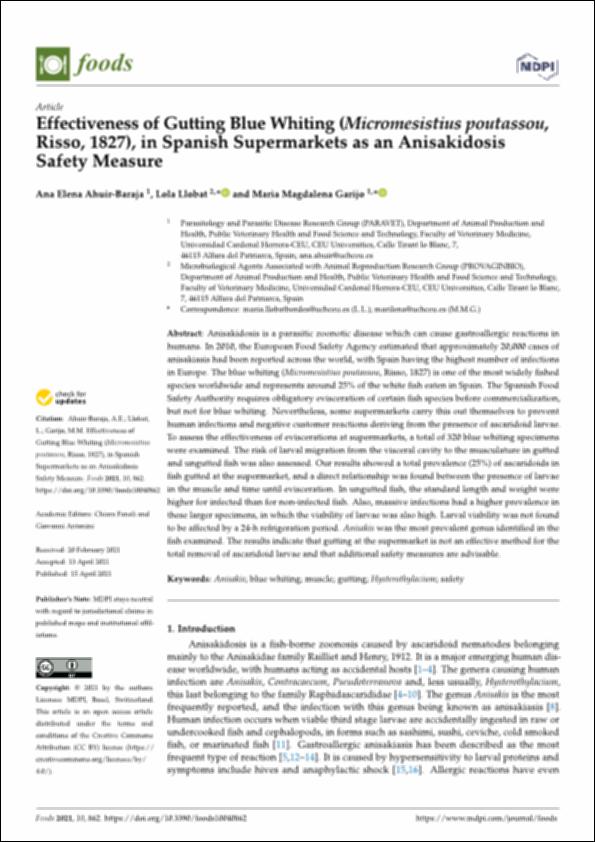Por favor, use este identificador para citar o enlazar este ítem:
http://hdl.handle.net/10637/13446Effectiveness of gutting blue whiting (Micromesistius poutassou, Risso, 1827), in Spanish supermarkets as an anisakidosis safety measure
| Título : | Effectiveness of gutting blue whiting (Micromesistius poutassou, Risso, 1827), in Spanish supermarkets as an anisakidosis safety measure |
| Autor : | Ahuir Baraja, Ana Elena Llobat Bordes, Lola Garijo Toledo, María Magdalena |
| Materias: | Bacaladilla - Parásitos.; Blue whiting - Parasites.; Helmintiasis.; Food - Security.; Food - Quality.; Alimentos - Control de calidad.; Alimentos - Medidas de seguridad.; Helminthiasis. |
| Editorial : | MDPI |
| Citación : | Ahuir Baraja, A.E., Llobat, L. & Garijo, M.M. (2021). Effectiveness of gutting blue whiting (Micromesistius poutassou, Risso, 1827), in Spanish supermarkets as an anisakidosis safety measure. Foods, vol. 10, n. 4 (15 apr.), art. 862. DOI: https://doi.org/10.3390/foods10040862 |
| Resumen : | Anisakidosis is a parasitic zoonotic disease which can cause gastroallergic reactions in humans. In 2010, the European Food Safety Agency estimated that approximately 20,000 cases of anisakiasis had been reported across the world, with Spain having the highest number of infections in Europe. The blue whiting (Micromesistius poutassou, Risso, 1827) is one of the most widely fished species worldwide and represents around 25% of the white fish eaten in Spain. The Spanish Food Safety Authority requires obligatory evisceration of certain fish species before commercialization, but not for blue whiting. Nevertheless, some supermarkets carry this out themselves to prevent human infections and negative customer reactions deriving from the presence of ascaridoid larvae. To assess the effectiveness of eviscerations at supermarkets, a total of 320 blue whiting specimens were examined. The risk of larval migration from the visceral cavity to the musculature in gutted and ungutted fish was also assessed. Our results showed a total prevalence (25%) of ascaridoids in fish gutted at the supermarket, and a direct relationship was found between the presence of larvae in the muscle and time until evisceration. In ungutted fish, the standard length and weight were higher for infected than for non-infected fish. Also, massive infections had a higher prevalence in these larger specimens, in which the viability of larvae was also high. Larval viability was not found to be affected by a 24-h refrigeration period. Anisakis was the most prevalent genus identified in the fish examined. The results indicate that gutting at the supermarket is not an effective method for the total removal of ascaridoid larvae and that additional safety measures are advisable. |
| Descripción : | Este artículo se encuentra disponible en la siguiente URL: https://www.mdpi.com/2304-8158/10/4/862 Este artículo pertenece al número especial "Microbiological Safety and Quality of Food". |
| URI : | http://hdl.handle.net/10637/13446 |
| Derechos: | http://creativecommons.org/licenses/by/4.0/deed.es |
| ISSN : | 2304-8158 |
| Fecha de publicación : | 15-abr-2021 |
| Centro : | Universidad Cardenal Herrera-CEU |
| Aparece en las colecciones: | Dpto. Producción y Sanidad Animal, Salud Pública Veterinaria y Ciencia y Tecnología de los Alimentos |
Los ítems de DSpace están protegidos por copyright, con todos los derechos reservados, a menos que se indique lo contrario.


